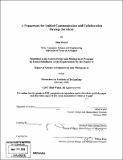| dc.contributor.advisor | Michael Allan Martin Davies. | en_US |
| dc.contributor.author | Wahid, Bilal | en_US |
| dc.contributor.other | System Design and Management Program. | en_US |
| dc.date.accessioned | 2008-11-07T19:02:50Z | |
| dc.date.available | 2008-11-07T19:02:50Z | |
| dc.date.copyright | 2007 | en_US |
| dc.date.issued | 2008 | en_US |
| dc.identifier.uri | http://hdl.handle.net/1721.1/43104 | |
| dc.description | Thesis (S.M.)--Massachusetts Institute of Technology, System Design and Management Program, February 2008. | en_US |
| dc.description | Includes bibliographical references (p. 56-57). | en_US |
| dc.description.abstract | Unified Communication and Collaboration (UCC) is a product offer that is the result of fixed and mobile networks convergence and the possibility of development of applications which are interoperable. Currently there are stand-alone products such as VoIP, VPN, Contact Center, Conferencing, Security Services, Email, IM, Presence and others which operate in silos and have complicated and difficult interoperability. In addition, applications are difficult to develop on top of this disparate infrastructure. The convergence of all communication networks on Internet Protocol (IP) and the emergence of more open software platforms have enabled a new paradigm- UCC - to emerge that will change how people communicate and collaborate.The purpose of this paper to analyze the impact of changing communication needs on vendors in general, with a specific emphasis on incumbent telecommunication carriers - network operators and service providers - so-called "telcos". It further illustrates a framework through which an incumbent telco can clearly identify an appropriate strategy for Unified Communication and Collaboration which utilizes its legacy strengths while moving towards innovation.In this paper, an analysis of publicly available data from research companies is performed; Unified Communication and Collaboration is fully defined; market drivers in large enterprise (often known as just Enterprise), and in small and medium business (also called SMB) are analyzed; competitive analysis of Unified Communication and Collaboration equipment vendors and carriers is illustrated; and an appropriate architecture for UCC is outlined. Special focus is given to incumbent telco's role, in comparison to equipment vendors, in the emerging Internet Protocol (IP) based communication technologies which are undergoing active diffusion. | en_US |
| dc.description.abstract | (cont.) The result shows that carriers have more opportunity to capture value through hosted UCC in small and medium business (SMB) market as compared to large Enterprise. Existing hardware communication vendors are better positioned to get the major share of large Enterprise through software based customer premises equipment (CPE) UCC but carriers have an opportunity to provide software as a service (SAAS) services and to exploit their existing distribution channels. | en_US |
| dc.description.statementofresponsibility | by Bilal Wahid. | en_US |
| dc.format.extent | 75 p. | en_US |
| dc.language.iso | eng | en_US |
| dc.publisher | Massachusetts Institute of Technology | en_US |
| dc.rights | M.I.T. theses are protected by
copyright. They may be viewed from this source for any purpose, but
reproduction or distribution in any format is prohibited without written
permission. See provided URL for inquiries about permission. | en_US |
| dc.rights.uri | http://dspace.mit.edu/handle/1721.1/7582 | en_US |
| dc.subject | System Design and Management Program. | en_US |
| dc.title | A framework for Unified Communication and Collaboration strategy for telcos | en_US |
| dc.title.alternative | Framework for UCC strategy for telcos | en_US |
| dc.type | Thesis | en_US |
| dc.description.degree | S.M. | en_US |
| dc.contributor.department | System Design and Management Program. | en_US |
| dc.identifier.oclc | 244635874 | en_US |
